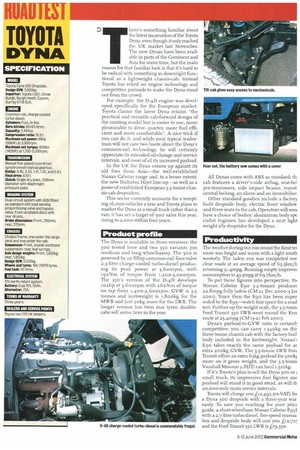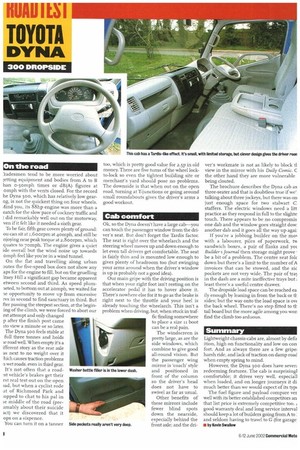I lere's something familiar about the latest incarnation of the
Page 26

Page 28

If you've noticed an error in this article please click here to report it so we can fix it.
Toyota Dyna, even though it only reached the UK market last November. The new Dynas have been available in parts of the Continent and Asia for some time, but the main reason for that familiar look is that it's hard to be radical with something as downright functional as a lightweight chassis-cab. Instead Toyota has relied on engine technology and competitive payloads to make the Dyna stand out from the crowd.
For example, the D-4D engine was developed specifically for the European market. Toyota claims the latest Dyna retains "the practical and versatile cab-forward design of the existing model but is easier to use, more pleasurable to drive, quieter, more fuel efficient and more comfortable". A nice trick if you can do it, and while your typical tradesman will not care two hoots about the Dyna's common-rail technology, he will certainly appreciate its extended oil-change and service intervals, and most of all its increased payload.
In the UK the Dyna comes up against its old foes from Asia—the well-established Nissan Cabstar range and, to a lesser extent, the new Daihatsu Hijet line-up—as well as a posse of established European 3.5-tonne chassis-cab dropsiders.
This sector currently accounts for a tempting t6,000 vehicles a year and Toyota plans to market the Dyna as a small truck rather than a van; it has set a target of 900 sales this year, rising to 2,000 within four years.
Product profile
The Dyna is available in three versions: the 300 tested here and two 350 variants (on medium and long wheelbases). The 300 is powered by an 88hp common-rail four-valve 2.5-litre charge-cooled turbo-diesel producing its peak power at 3,600rpm, with 192Nm of torque from 1,200-3,000rpm. The 350's version of the D-4D develops To zhp at 3, 6 o o rpm with 26 oN m of torque on tap from 1,400-2,600rpm. GVW is 3.5 tonnes and kerbweight is L800kg for the Is/MB and just 2 okg more for the LWB. The longer version has twin rear tyres; doublecabs will arrive later in the year.
All Dynas come with ABS as standard; th cab features a driver's-side airbag, seat-be] pre-tensioners, side impact beams, remot central locking, an alarm and an immobilise.
Other standard goodies include a factory built dropside body, electric front window and three seats in the cab. Operators will soot have a choice of bodies: aluminium body six cialist I ngimex has developed a neat ligh1 weight ally dropsider for the Dyna.
Productivity
The weather during our run round the Kent tee route was bright and warm with a light south westerly. The laden run was completed ove clear roads at an average speed of 65.51cm/h returning 31.4mpg. Running empty improve( consumption to 43.5mpg at 6 9.71cm/h.
To put these figures into perspective, thi Nissan Cabstar E90 3.2-tonner produce( 22.8mpg fully laden (CM 21 Dec 2000-3 Jar 2001). Since then the E90 has been super seded by the E95—watch this space for a road test. Further up the weight scale, the 3 .5-tonni Ford Transit 35o LWB went round the Ken route at 25.4mpg (CMI5-2i Feb 2001).
Dyna's payload-to-GVW ratio is certainl competitive: you can carry 1,340kg on thi: three-tonne chassis-cab with the factory-buil body included in the kerbweight. Nissan': Ego takes exactly the same payload for ar extra 200kg CVW. The 3.5-tonne LWB For Transit offers an extra 65kg payload for 5ook4 more on it gross weight, and the 3.5-torin( Vauxhall Movano 2.8DTi can haul 1,510lcg.
If it's Toyota's plan to sell the Dyna 300 as small truck, its impressive fuel figures anc payload will stand it in good stead, as will it 20,000-mile main service intervals.
Toyota will charge you £12,495 (ex-VAT) fo: a Dyna 300 dropsicle with a three-year war ranty. To save you reaching for your pricc :guide, a short-wheelbase Nissan Cabstar E95I with a 2.7-litre turbo-diesel, five-speed manna box and clropside body will cost you £12,72c and the Ford Transit 350 LWB is £19,350.
On the road
Iadesmen tend to be more worried about ;etting equipment and bodies from A to B han 0-50mph times or dB(A) figures at omph with the vents closed. For the record he Dyna 300, which has relatively low gearng, is not the quickest thing on four wheels. 'find you, its 88hp engine was more than a natch for the slow pace of cockney traffic and t did remarkably well out on the motorway, ven if it felt like it needed a sixth gear.
To be fair, fifth gear covers plenty of ground: ou can sit at r,600rpm at 40mph, and still be njoying near peak torque at 2,800rpm, which quates to 70mph. The engine gives a quiet ide overall but the wind noise up towards omph feel like you're in a wind tunnel.
You can turn it on a tanner too, which is pretty good value for 2.5p in old money. There are five turns of the wheel lockto-lock so even the tightest building site or merchant's yard should pose no problems. The downside is that when out on the open road, turning at T-j unctions or going around small roundabouts gives the driver's arms a good workout.
Cab comfort
Ok, so the Dyna doesn't have a large cab—you can touch the passenger window from the driver's seat. But don't forget the Tardis factor. The seat is right over the wheelarch and the steering wheel moves up and down enough to let even tall drivers get comfortable. The seat is fairly thin and is mounted low enough to gives plenty of headroom too (but swinging your arms around when the driver's window is up is probably not a good idea).
Our main gripe with the driving position is that when your right foot isn't resting on the accelerator pedal it has to hover above it. There's nowhere else for it to go as the brake is right next to the throttle and your heel is already touching the wheelarch. This isn't a problem when driving, but, when stuck in traffic finding somewhere to place a size II boot can be a real pain.
The windscreen is pretty large, as are the side windows, which combine to give good all-round vision. But the passenger wing mirror is 'coach' style and positioned in front of the column so the driver's head does not have to swivel as far as usual.
Other benefits of these mirrors include fewer blind spots down the nearside, especially behind the front axle; and the dri ver's workmate is not as likely to block ti view in the mirror with his Daily Comic. C the other hand they are more vulnerable being clouted.
The brochure describes the Dyna cab as three-seater and that is doubtless true if we' talking about three jockeys, but there was on just enough space for two stalwart C. staffers. The electric windows need a litt practice as they respond in full to the slighte touch. There appears to be no compromis one dab and the window goes straight dow another dab and it goes all the way up agai: If you're a jobbing builder on the mot with a labourer, piles of paperwork, ill sandwich boxes, a pair of flasks and yot Builder s Journal then storage might prove • be a bit of a problem. The centre seat folc down but there's a limit to the number of A invoices that can be stowed, and the sic pockets are not very wide. The pair of tra) in the dash are a mite ineffective trays but . least there's a useful centre drawer.
The dropside load space can be reached ea ily enough by leaning in from the back or sides; but the way onto the load space is ow the back wheel. There's no step fitted to tk tail board but the more agile among you won find the climb too arduous.
Summary
Lightweight chassis-cabs are, almost by defu ition, high on functionality and low on con fort. And as always there are a few gripe: harsh ride, and lack of traction on damp road when empty spring to mind.
However, the Dyna 300 does have seven redeeming features. The cab is surprising] comfortable; it drives very well, especial] when loaded, and on longer journeys it di much better than we would expect of its type The fuel figure and payload compare vet well with its better established competitors an that list price is extremely competitive too. good warranty deal and long service interval should keep a lot of builders going from A to and seldom having to travel to G (for garage
• by Kevin Swallow




















































































































































